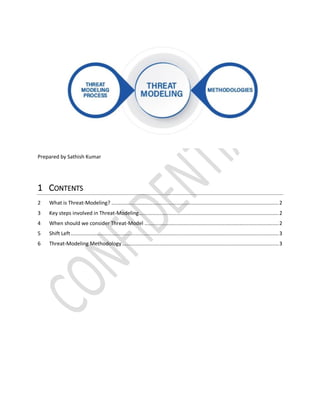Threat-Model.pdf
•
0 likes•9 views
Threat modeling is a structured approach used in cybersecurity and software development to identify and assess potential security threats and vulnerabilities in a system or application. It involves analyzing the system's architecture, components, data flow, and interactions to understand where security risks might arise and how to mitigate them. Threat modeling is crucial for several reasons:
Report
Share
Report
Share

Recommended
Recommended
More Related Content
Similar to Threat-Model.pdf
Similar to Threat-Model.pdf (20)
idsecconf2023 - Mangatas Tondang, Wahyu Nuryanto - Penerapan Model Detection ...

idsecconf2023 - Mangatas Tondang, Wahyu Nuryanto - Penerapan Model Detection ...
SECURITY BRIEFING companion to HPSR Security Briefing 13

SECURITY BRIEFING companion to HPSR Security Briefing 13
O'Reilly SACon 2019 - (Continuous) Threat Modeling - What works?

O'Reilly SACon 2019 - (Continuous) Threat Modeling - What works?
Toward a Trusted Supply Chain White Paper from Microsoft

Toward a Trusted Supply Chain White Paper from Microsoft
Recently uploaded
Recently uploaded (20)
Design and Development of a Provenance Capture Platform for Data Science

Design and Development of a Provenance Capture Platform for Data Science
Decarbonising Commercial Real Estate: The Role of Operational Performance

Decarbonising Commercial Real Estate: The Role of Operational Performance
Elevate Developer Efficiency & build GenAI Application with Amazon Q

Elevate Developer Efficiency & build GenAI Application with Amazon Q
Polkadot JAM Slides - Token2049 - By Dr. Gavin Wood

Polkadot JAM Slides - Token2049 - By Dr. Gavin Wood
Cloud Frontiers: A Deep Dive into Serverless Spatial Data and FME

Cloud Frontiers: A Deep Dive into Serverless Spatial Data and FME
Less Is More: Utilizing Ballerina to Architect a Cloud Data Platform

Less Is More: Utilizing Ballerina to Architect a Cloud Data Platform
How to Check CNIC Information Online with Pakdata cf

How to Check CNIC Information Online with Pakdata cf
Navigating Identity and Access Management in the Modern Enterprise

Navigating Identity and Access Management in the Modern Enterprise
WSO2 Micro Integrator for Enterprise Integration in a Decentralized, Microser...

WSO2 Micro Integrator for Enterprise Integration in a Decentralized, Microser...
Intro to Passkeys and the State of Passwordless.pptx

Intro to Passkeys and the State of Passwordless.pptx
Web Form Automation for Bonterra Impact Management (fka Social Solutions Apri...

Web Form Automation for Bonterra Impact Management (fka Social Solutions Apri...
Vector Search -An Introduction in Oracle Database 23ai.pptx

Vector Search -An Introduction in Oracle Database 23ai.pptx
JavaScript Usage Statistics 2024 - The Ultimate Guide

JavaScript Usage Statistics 2024 - The Ultimate Guide
Stronger Together: Developing an Organizational Strategy for Accessible Desig...

Stronger Together: Developing an Organizational Strategy for Accessible Desig...
Threat-Model.pdf
- 1. Prepared by Sathish Kumar 1 CONTENTS 2 What is Threat-Modeling? ...............................................................................................................2 3 Key steps involved in Threat-Modeling.............................................................................................2 4 When should we consider Threat-Model .........................................................................................2 5 Shift Left..........................................................................................................................................3 6 Threat-Modeling Methodology........................................................................................................3
- 2. 2 WHAT IS THREAT-MODELING? Is a proactive approach to identify and mitigate potential threats and vulnerabilities. 3 KEY STEPS INVOLVED IN THREAT-MODELING. 1. Scope definition. 2. Identifying Asset - Identifying critical assets and understanding the value of them. 3. Identifying potential threat - Brainstorm and identify different potential threat involved. Threat categorizes can be tech or non tech, includes, SQL injection, Data breaches, Un- authorized access, social engineering, etc. 4. Identifying vulnerabilities – weakness in our environment. 5. Analyzing Risks – evaluate potential Impact and likelihood of previously identified threats. For instance, evaluating how ease of exploitation of threat, lack of security controls or historical incident data. 6. Prioritize and mitigate Risk – Here we prioritize Identified Risks based on their severity, likelihood, and potential Impact. Also Identify the countermeasure to mitigate those risks, for instance, following secure coding practices, enhancing access controls, performing security testing, or adding IPS/IDS. 7. Document and communicate – to relevant stakeholders (developers, architects, security teams, management) 8. Validate and update – this is a continuous process, system evolve, or new threat identified must follow the threat modeling. 4 WHEN SHOULD WE CONSIDER THREAT-MODEL 1. During the design phase of SDLC. 2. When major changes are made. 3. During iterative development. 4. During system upgrades or updates. 5. When integrating third party components or services. 6. Ongoing monitoring and maintenance.
- 3. SDLC Life Cycle and Corresponding threat-model: Threat-Model Pentest Disclosure Big bounty Automated Code Review/ Security checks Static code in Pipeline Analysis Almost in every phase of SDLC we perform some or other security related tasks, then why it is important that threat model and why it as to perform early phase of software development? 5 SHIFT LEFT Is the answer for this question, for people doesn’t know what Is shift left is process of incorporating security measures and testing early in the software development lifecycle (SDLC) or Devops process. This approach aims to identify and address security issues as early as possible. Advantages of this approach, early risk identification, cost effective (fixing defects in early stage is cost effective), Security by design. 6 THREAT-MODELING METHODOLOGY In general, there are several threat modeling methodologies like (STRIDE, DREAD, PASTA, Trike, OCTAVE, Kill Chain, HARA, VAST, CARVER, VAPT) We are going to see in detail about STRIDE. Initiation Requirement Design Build Test Deploy Maintain
- 4. STRIDE – Six common threat categories. • Spoofing: Attackers show themselves as legitimate users. Authentication • Tampering: Unauthorized modification or alteration data or software, either in transit or modify file to achieve their malicious activity. Integrity • Repudiation: involves denial of action or event by a user or system entity. Non-repudiation • Information Disclosure: this breaks the security principle of confidentiality. • DOS: Aim to distract or disable the service. Availability • Elevation of privilege: can break any of CIA involve unauthorized escalation of user privileges or access rights within a system, they claim higher privileges to attempt their activities. Pros: Comprehensive coverage. Clear categorization, Scalable from small to large scale. Cons: Simplistic categorization, lack of prioritization its just give framework, limited guidance on Countermeasures.